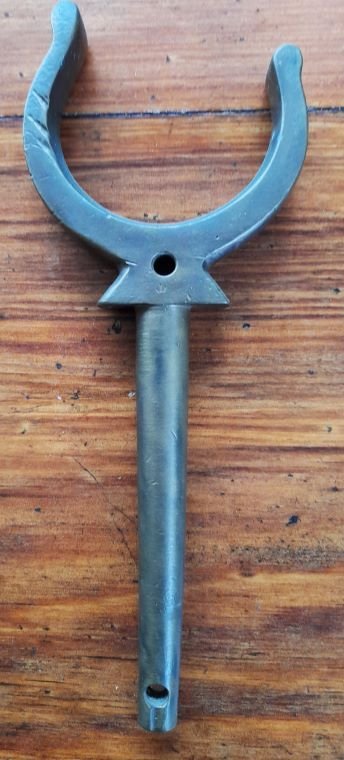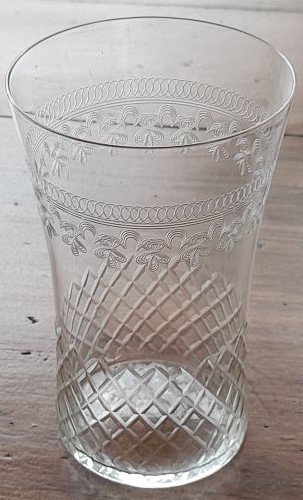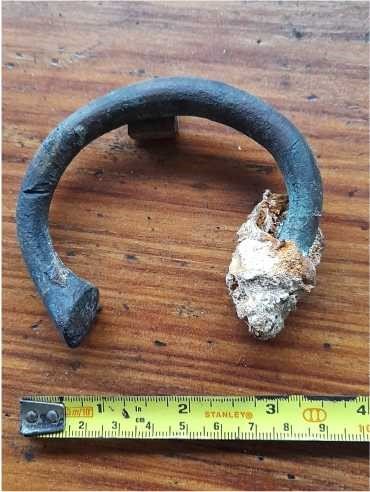Relics from the Hatsuyuki
These are works of art and are very special. Much angst went into retrieving them because, unlike merchant shipping where portholes are bolted on, these have 14 rivets to the hull.
The Hatsuyiki’s porthole
These portholes are works of art and are very special. Much angst went into retrieving them because, unlike merchant shipping where portholes are bolted on, these have 14 rivets to the hull.
Porthole from the Haysuyuki
How to get them off? A lot of thought and patience.
Banging the ship’s hull around the porthole with a dead blow hammer made the initial corrosion flake off, exposing the new metal to the saltwater. Do this 3-4 times over the course of a year. Payday comes, when with a punch and hammer, the now corroded but smaller rivets pop out. You then have to go inside the ship with a fine prybar to break the sealing gasket away from the hull. Careful manoeuvring with a lift bag to give it neutral buoyancy gets it out of the ship and up to the surface.
Each porthole is individually numbered and bears the Imperial Japanese Navy insignia. They are heavy solid brass, but the deadlight which is cast iron has long corroded away.
A lot of trouble, but well worth the effort to retrieve.
I still admire and treasure them after nearly 50 years.
Table Lamp
Table lamp from the Hatsuyuki
I retrieved eight of these lamps in one very fortunate dive from the officers’ quarters. One went to each of the other six divers in our group that day. I must have been suffering from nitrogen narcosis or something!
I still have two which are restored to working order. They are heavy solid brass with a fluted glass shade.
Each bears the insignia of the IJN (Imperial Japanese Navy). Around the base is a brass maker’s plate.
The compass from the Hatsuyuki
This was found by my mate Ray Leddick, but ended up in my possession in a swap deal. It was found in the bridge area and unfortunately, severely damaged.
There’s a lot of Japanese writing around the rim that needs to be translated. Probably the maker’s details.
Calligraphy items
The uppermost item in the image above is a heavy brass paper weight of which there would have been a pair. In Japanese these are called ‘bunchin’. The item to the lower right is a water dropper, and in Japanese is called ‘suiteki’. These are meant to have water in them and by using a finger over one of the holes, water can be precisely measured out to mix with an inkstick on the inkstone (to the left) to form a liquid ink of the required consistency. This suiteki is ceramic. The inkstone is called ‘suzuri’.
Glassware and ceramics
Menuma is a town in Japan and pomade is a hair cream, so I assume it is a container of hair cream made in Menuma. The beautiful blue lettering contrasts the ceramic crazing. The small blue wine glass is severely cracked but fully intact. Remarkable considering the explosions and sinking that took it to the bottom of the ocean.
Medicinal Items
All of these items came from the ship’s infirmary. Who knows what medicines are inside the ampoules?
Name tag
Each individual on the ship would have had one of these tags made of wood, with their name on it. They would be mounted onto a large board. At a glance anyone would be able to see if a person was on board or ashore on leave, for instance. What is remarkable is that this piece of wood has survived all the years underwater. The wording is ‘kanji’ and translates to: “Left side of the boat, Hashimoto Hayatsumu”.
Thank you, Nobu and Fiona Watanabe, for your translations of this and other items.
Lifeboat Rowlock
A heavy brass rowlock. Numbered and stamped with the IJN anchor insignia.
Voicetube mouthpiece
This copper mouthpiece was found in the bridge area and would have been mounted onto a tube so that someone could verbally communicate with another crew member in another section of the ship. If only we could recapture what has been said via this mouthpiece over the years.
Drinking glass
Very finely engraved, this glass is so thin and delicate that you fear, just by holding it, that it may break.
Yet it too had been subject to the bombing and sinking of a ship and remains completely intact.
Who else has held this glass and where did it come from?
In search of the Hatsuyuki
A story about a shipwreck dive in south Bougainville in 1975.
My good friend Ray Leddick and I left Kieta before daylight to travel more than 100 km down the east coast of Bougainville Island in my 13-foot ‘tinny’. Our destination was the south coast of Bougainville, very close to the Solomon Islands border …
The Japanese destroyer Hatsuyuki (1928). Image from Wikipedia.
My good friend Ray Leddick and I left Kieta before daylight to travel more than 100 km down the east coast of Bougainville Island in my 13-foot ‘tinny’. Our destination was the south coast of Bougainville, very close to the Solomon Islands border. This was the Buin — Kahili — Tonelei Harbour area where the Japanese had a massive base during the Second World War. This was their jump-off point for the Solomon Islands campaign.
Every time I was to come to this place, its beauty held me spellbound; a myriad of small islands scattered in all directions, there was the daily build-up of storm clouds over the mountains of Bougainville and Choiseul, and on that day the ocean was like a millpond.
From a chance encounter, some months earlier, we had been given a hand-drawn map giving us the approximate location of a shipwreck. Looking back, it was more like a pirate’s map, with hills, trees, islands, and other features to line up and find the ‘X’. For treasure hunters, we carried very sophisticated locating equipment, namely a grappling anchor attached to a couple of hundred feet of rope. This was dragged along the bottom hoping to find that needle in a haystack. We had come in search of the Hatsuyuki, a destroyer belonging to the Japanese Imperial Navy.
Hatsuyuki, meaning winter’s first snow, was one of 20 Fabuki-class destroyers built between 1927 and 1931. This class surpassed in design, any other destroyer type that was being planned or built anywhere in the world at that time. These vessels were the first to be fitted with oxygen-driven Long Lance torpedoes that were used so effectively throughout the war and caused such havoc to Allied shipping.
Colourised photo of the Hatsuyuki, underway at full speed 1928. Image from World of Warships
Hatsuyuki was a support vessel in what the Americans called the Tokyo Express, the Japanese attempt to recapture Guadalcanal and drive the Americans from the Solomon Islands. On the 17th of July 1943, a large formation of American fighters from Guadalcanal assembled to attack shipping in the Buin — Kahili area of south Bougainville. The Hatsuyuki was crippled by a direct hit and sank immediately about a mile from shore, with a loss of some 120 lives.
Later research would reveal that Hatsuyuki had participated in the Battle of Sunda Strait on 1st March 1942, and had participated in the sinking of HMAS Perth and the USS Houston. She also took part in the Battle of Midway on 4th and 5th June 1942.
Ray and I were hoping to find her final resting place but after several hours our enthusiasm was waning. A villager whom we had noticed earlier observing us, paddled towards us in his canoe. His curiosity had got the better of him and he was no doubt wondering what the white fellas were up to.
In Pidgin, I explained that we were looking for a ship wreck from “taim bilong bikpela pait wantaim Japan”…..the Second World War. He didn’t know about a ship but turning slightly on his canoe, he pointed to a place nearby where people from his village came because something on the seafloor attracted schools of fish. The man paddled about 100 metres and pointed downwards. As our grappling hook snagged metal, it all seemed too good to be true. I thanked our acquaintance and we quickly geared up and went over the side.
The water was alive with pelagics, schools of big trevally, mackerel, barracuda, and angel fish. At 60 feet we could make out the ship’s outline and at 85 feet, in poor visibility, we were on what turned out to be the stern. Being right next to a twin-gun turret with its door open, I couldn’t resist going inside. The barrels were pointing upwards at a 45-degree angle and I began to imagine the frantic actions of the gun crew on that fateful day. Trying to defend their ship from the American planes that were equally intent on sinking it. This dive was to be an exploratory one to see as much of the ship as possible and seek out areas for closer examination on future expeditions
Our dive revealed that the whole mid-section of the ship had been extensively damaged, but from what was told, most of this was caused in the 1960s by commercial salvagers who removed the turbines and propellors. Much of the superstructure had been blown off and lay strewn across the ocean floor, while the deck had collapsed inward, making it difficult to gain access inside.
The Hatsuyuki was heavily damaged in 1935 during a typhoon while carrying out war game manoeuvres. Image from Reddit.
We were to return some 15 times over the next couple of years, locating among other things, the officer’s quarters and the ship’s infirmary. Many artifacts were located including a very fine and intricately engraved drinking glass, so fine I was scared that just by holding it, I’d break it, and yet it had survived untold explosions that ripped the ship apart. The officer’s mess gave up some beautiful solid brass table lamps bearing the insignia of the Japanese Imperial Navy. Portholes that were salvaged are like no others I have seen; they are very unique and rare.
I am fortunate to have dived on dozens of wrecks throughout PNG but they have all been cargo vessels or barges, and whilst that was exciting, it is rare to dive on a capital ship that is in relatively shallow water. Most are in deep, inaccessible places.
Time never seemed long enough while we were down, and each dive ended with planning for the next. I don’t think many people know the location of this ship, and with the conflict that raged on Bougainville in the 1980s and ‘90s, it certainly would not have been dived on for many years
Hatsuyuki, rust in peace, and vale to my good friend and dive buddy, Ray Leddick.
This has brought back so many good memories of my time living in PNG.
Chris Leonard — March 2022
Turtle Tales
Coochiemudlo Island is fortunate to have a dedicated and trained crew who act as first responders to rescue and deal with injured or dead turtles on and around our island.
Burying a dead turtle on Coochiemudlo Island, Moreton Bay, South East Queensland.
Coochiemudlo Island is fortunate to have a dedicated and trained crew who act as first responders to rescue and deal with injured or dead turtles on and around our island.
We have protocols in place to respond to each incident and collect information that is fed into a Queensland-wide database. This is used over time to form a picture of what is happening within our greater turtle population. With each encounter, we try and determine a cause of death - key causes of injuries to turtles and solutions to follow:
Coochiemudlo Island is fortunate to have a dedicated and trained crew who act as first responders to rescue and deal with injured or dead turtles on and around our island.
We have protocols in place to respond to each incident and collect information that is fed into a Queensland-wide database. This is used over time to form a picture of what is happening within our greater turtle population. With each encounter, we try and determine a cause of death - key causes of injuries to turtles and solutions to follow:
1 The most common being boat or jetski strikes.
These cause horrific injuries that are most upsetting, even to us hardened bunch. It is no different to being on the road: speed kills. In this case, it is the turtles that suffer. If you could see what we see, I am sure that the majority of people would act differently out on the water. Slow down on the water.
2 Ensure your crab pots have ‘turtle excluders’.
Recently I had to deal with a turtle that was trapped inside a crab pot. This beautiful and otherwise healthy animal had drowned. This pot was not fitted with a turtle excluder which would have gone some way to stop it from getting inside. Excluders are not mandatory by law; however, I feel that they should be. Generally, the more expensive pots have them fitted. Please check your pots to see if you have them.
3 Please make sure that your float ropes are ‘weighted’.
This will reduce the chance of a floating rope being cut by a boat propellor and the now lost pot becoming a ‘ghost pot’ that can go on trapping and killing marine life.
4 Ensure that your pot is put in enough depth of water that it is not exposed at low tide.
We have had cases where birds of prey have become entangled and would have drowned if not rescued in time.
We all enjoy what our beautiful oceans provide, so please help our turtles when you venture into their environment.
Slave Trade ‘bracelet money’ found on our local beach
Found at low tide by Chris Leonard: a Manilla that was used as a form of currency to trade slaves. But how did it end up on a beach on Coochiemudlo Island?
During a particularly low tide event on Norfolk Beach mud flats very near to our home on Coochiemudlo Island, some four to five years ago, I found a metal object that I thought was part of a ship’s rigging.
The item is brass or bronze and has coral growth which indicates that it had been in the ocean for a considerable time. Being a bowerbird, I brought it home and used it as decoration on a Buddha statue in my garden.
About two years ago the ABC was doing a promo for an upcoming series called ‘Enslaved’. Someone held up an object the same as mine and exclaimed: “You could buy and sell slaves with these.” That got me going.
What I had found is called a Manilla.
Tens of millions of these objects were made primarily for the West African slave trade between the 15th and 19th centuries. They were used as a form of currency to buy and trade slaves. All of the major European powers were involved and at the time, was a lucrative trade that trafficked millions of people.
Part of my research involved contacting the Queensland Museum, and from their response to my many questions, there are no reports of them being used in the Pacific Blackbirding trade. I put a question to them: “Is it possible that it was carried by Matthew Flinders?”
The response was: “Maybe. Metal was a desirable trade good and many of the British sailors and people of status would have known about Manillas”.
I wish I could remember exactly where it was that I found it as I believe there could be more. I will be out there on those very low-tide events, trying to solve the mystery of the Manilla.
Watch the program ‘Enslaved’ on the Australian Broadcasting Commission’s iview even if you only see Episode 1. The story is compelling, confronting, and well-narrated.















